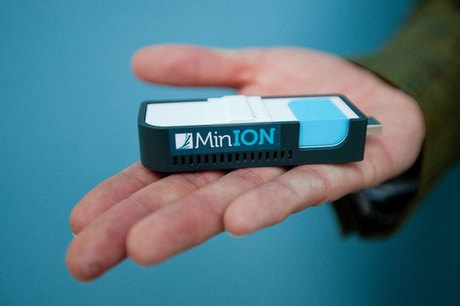$1000 genome might be just around the corner

Oxford Nanopore has shaken up the genome sequencing world by demonstrating a new technology based on its nanopore technology that could deliver a $1000 genome in under an hour by 2013.
The demonstration of the GridION sequencer was given by the company’s chief technology officer, Clive Brown, at the Advances in Genome Biology and Technology conference in Florida on February 17 to a packed room.
GridION is based on Oxford Nanopore’s own “new generation” of single-strand sequencing technology, featuring accurate long reads of single-stranded DNA molecules, and showed off two viral genomes that have already been sequenced by it.
Each GridION node and cartridge is initially designed to deliver tens of Gb of sequence data per 24 hour period, with the user choosing whether to run for minutes or days according to the experiment.
Brown also announced a new portable cartridge version called MinION that is so compact it can fit on to a device that doubles as a USB drive and can be plugged into a computer to sequence a genome on the spot.
During the demonstration, Brown offered the prospect of achieving a $1,000 genome in 2013 in under an hour by harnessing 20 GridION nodes working with a second-generation nanopore array.
This compares to the current state-of-the-art next (or second) generation sequencers from Life Technologies and Illumina that cost in the tens or hundreds of thousands of dollars, although the latest devices on offer promise a single human genome for less than $1000 each.
The sequencer is based on Oxford’s nanopore technology which passes the DNA strand through a protein pore which identifies each base as it goes through. Brown claims a raw error rate of only 4%.
The devices has a built-in ASIC (application-specific integrated circuit) that serves as a low-noise amplifier, a digital-to-analogue convertor on a parallel chip that sits underneath the biological chip.
The MinION devices should retail for less than US$900 ($840) and contains one ASIC and 512 channels, capable of producing about 120 megabases sequence per hour. The device literally plugs into a USB port on a laptop or desktop.
Brown also showed off two viruses that have been sequenced with the technology, including PhiX174, which was the first organism sequenced by Fred Sanger in the 1970s, and the bacteriophage lambda, which is about 10 times larger.
The GridION and MinION devices should be available later this year.
AI-designed DNA switches flip genes on and off
The work creates the opportunity to turn the expression of a gene up or down in just one tissue...
Drug delays tumour growth in models of children's liver cancer
A new drug has been shown to delay the growth of tumours and improve survival in hepatoblastoma,...
Ancient DNA rewrites the stories of those preserved at Pompeii
Researchers have used ancient DNA to challenge long-held assumptions about the inhabitants of...




